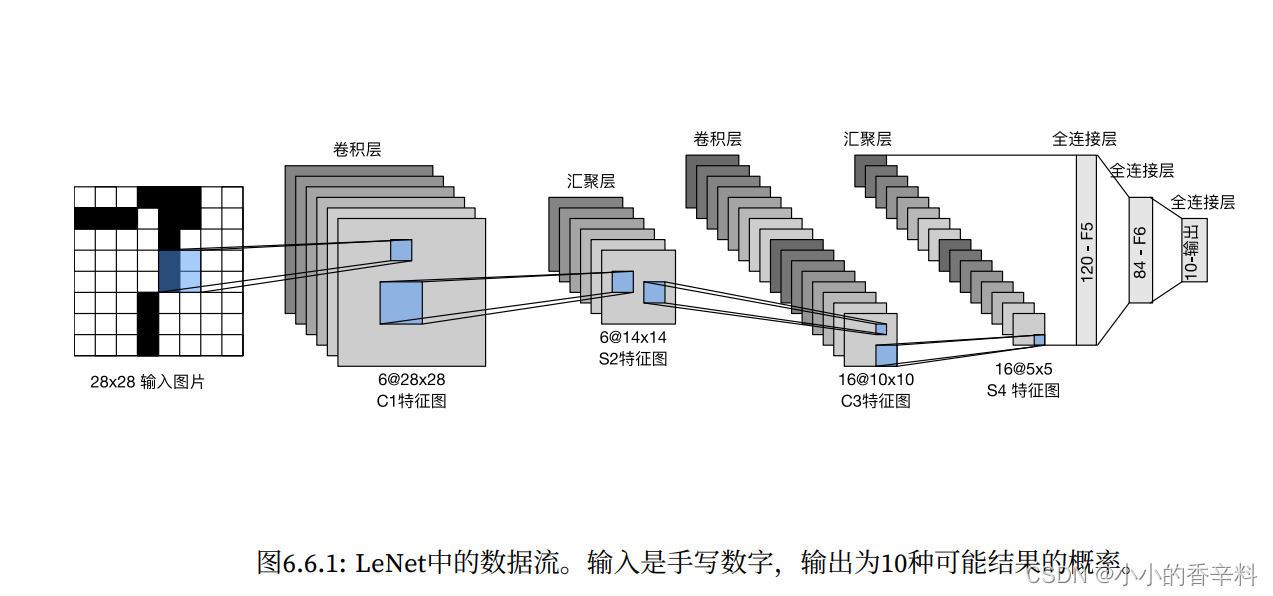参考沐神
LeNet的结构图

这里沐神稍微做了一点小小的变化,就是最后全连接后面的高斯连接层去掉了,其他和LeNet是完全一样的!
LeNet流程?
输入图片为28*28,经过2次卷积+池化操作,最后接3个全连接层。
具体来说:
- 输入通道数为1,长宽为28*28的图片,可以是批量输入,则对应数字应进行适当修改。这里以1*1*28*28为例,即1张通道数为1的28*28的图片。
- 使用大小为5*5卷积核对输入卷积,设定输出通道数为6,得到大小为28*28的c1特征图。然后将c1过一下sigmoid函数。
- 对c1使用平均池化得到大小为14*14的特征图s2(池化操作不改变通道数)
- 使用大小为5*5卷积核对特征图s2卷积,设定输出通道数为16,得到大小为10*10的c3特征图。然后将c3过一下sigmoid函数。
- 对c3使用平均池化得到大小为5*5的特征图s2(池化操作不改变通道数)
- 使用nn.Flatten()将除了第一个维度外的其他维度拉成一个维度,也就是降成二维(批量大小,通道数*长*宽),即(1,16*5*5)。
- 使用步骤6拉成二维就能使用全连接层了,使用3个全连接层,每层后跟一个sigmoid即可。三层全连接的输入输出分别为(16*5*5, 120)->sigmoid->(120, 84)->sigmoid->(84, 10)。因为这里用的是mnist_fashion数据集,共有10类,故最后一层全连接输出10类。
关于图片原始尺寸经过卷积层、池化层后的尺寸,使用下面公式计算。?

代码如下:
#!/usr/bin/env python
# -*- coding: UTF-8 -*-
"""
@Project :深度学习入门
@File :LeNet实现.py
@Author :little_spice
@Date :2022/5/7 18:04
"""
import torch
from d2l import torch as d2l
from torch import nn
# LeNet结构
net = nn.Sequential(
# 这里padding=2是为了和LeNet图片尺寸保持一致,LeNet使用数据集图片大小为32*32
# 我们这里为28*28,padding=2后得到(28+4)*(28+4)
nn.Conv2d(1,6,kernel_size=5,padding=2),nn.Sigmoid(),
nn.AvgPool2d(kernel_size=2,stride=2),
nn.Conv2d(6,16,kernel_size=5),nn.Sigmoid(),
nn.AvgPool2d(kernel_size=2,stride=2),
nn.Flatten(),
nn.Linear(16*5*5,120),nn.Sigmoid(),
nn.Linear(120,84),nn.Sigmoid(),
nn.Linear(84,10)
)
X = torch.rand(size=(1, 1, 28, 28), dtype=torch.float32)
for layer in net:
X = layer(X)
# print(layer.__class__.__name__,'output shape: \t',X.shape)
batch_size=256
train_iter,test_iter = d2l.load_data_fashion_mnist(batch_size)
# 使用gpu评估精度
def evaluate_accuracy_gpu(net,data_iter,device=None):
"""使用gpu计算模型的精度"""
if isinstance(net,nn.Module):
net.eval()
if not device:
device = next(iter(net.parameters())).device
# 正确预测的数量,总预测的数量
metric = d2l.Accumulator(2)
with torch.no_grad():
for X,y in data_iter:
if isinstance(X,list):
X = [x.to(device) for x in X]
else:
X = X.to(device)
y = y.to(device)
metric.add(d2l.accuracy(net(X),y),y.numel())
return metric[0]/metric[1]
def train_ch6(net,train_iter,test_iter,num_epochs,lr,device):
"""用gpu训练模型"""
def init_weights(m):
if type(m)==nn.Linear or type(m)==nn.Conv2d:
nn.init.xavier_normal_(m.weight)
net.apply(init_weights)
print('training on ',device)
net.to(device)
optimizer = torch.optim.SGD(net.parameters(),lr=lr)
loss = nn.CrossEntropyLoss()
# xlim限值x轴范围
animator = d2l.Animator(xlabel='epoch',xlim=[1,num_epochs],legend=['train loss','train acc','test acc'])
timer, num_batches = d2l.Timer(),len(train_iter)
for epoch in range(num_epochs):
# 训练损失之和,训练准确数之和,样本数
metric = d2l.Accumulator(3)
net.train()
for i,(X,y) in enumerate(train_iter):
timer.start()
optimizer.zero_grad()
X,y = X.to(device),y.to(device)
y_hat = net(X)
# pytorch自动帮我们求了平均loss,如果要求总体loss还要对l乘X.shape[0]
l = loss(y_hat,y)
l.backward()
optimizer.step()
with torch.no_grad():
metric.add(l*X.shape[0],d2l.accuracy(y_hat,y),X.shape[0])
timer.stop()
# 平均loss
train_l = metric[0]/metric[2]
# 计算训练准确率
train_acc = metric[1]/metric[2]
if (i+1)%(num_batches/5) == 0 or i==num_batches-1:
animator.add(epoch+(i+1)/num_batches,(train_l,train_acc,None))
test_acc = evaluate_accuracy_gpu(net,test_iter)
animator.add(epoch+1,(None,None,test_acc))
print(f'loss:{train_l:.3f},train_acc:{train_acc:.3f},test_acc:{test_acc:.3f}')
print(f'{metric[2] * num_epochs / timer.sum():.1f} examples/sec 'f'on {str(device)}')
lr, num_epochs = 0.9, 10
train_ch6(net, train_iter, test_iter, num_epochs, lr, d2l.try_gpu())
